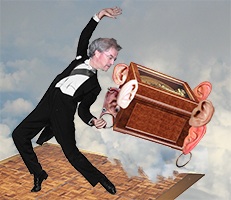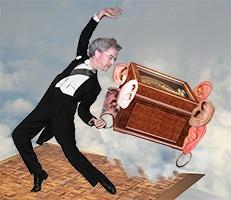
Slonimsky’s Earbox opened the evening. Inspiring the musicians, dancing like a marionette with frenzied gestures and spasmodic knee-bends, Vänskä revealed this 14-minute power plant to be one of Adams’ finest works. Its title comes from Nicolas Slonimsky’s book Thesaurus of Scales and Melodic Patterns, which Adams says had “a singular impact on my music for years” as a grab-bag toolbox (read: “earbox”) of effervescent musical ideas. And the piece is full of them, all tied together by an energetic pulse and recurring phraselets.
The work is a miniature concerto for orchestra, since almost all the instruments get their moments in the sun — especially the violas and keyboards (piano and sampler). The former, in particular, impressed me, by comparison with their scratchy counterparts in the Kent Nagano recording with the Hallé orchestra. Why the Symphony had never performed this local composer’s 1995 work earlier is quite beyond my comprehension, considering its quality, brevity, and entertainment value. All patrons I interviewed at intermission were enthusiastic about the music, one senior lady telling me she couldn’t wait to get it onto her iPod.
Less-Welcome Revivals
The rest of the concert consisted of works all too recently performed here: Tchaikovsky’s First piano concerto and Dvořák’s Seventh Symphony. In the concerto, the 30-year-old Siirala, who hails from Helsinki, brandished his Lisztian octaves with confidence, but seemed to ignore much of the poetry, however familiar to audiences, in the music. I wish I had heard a more gradational approach to dynamics, smoother transitions, and greater tonal variety. Siirala’s relatively rigid body language and inability to smile did not encourage his audience: There was no applause between movements, and the de-rigueur standing ovation before intermission was more polite than enthusiastic. A charm-school course is advised.The Dvořák Seventh is one of the glories of the literature, full of energy and passion, but also of studied reflection, lightness, and charm. Unfortunately, Vänskä emphasized the energy and passion, to the detriment of the latter attributes. After the earlier works, having simply more energy and passion did not add to the cumulative experience of the evening when more was to be had in the score. The loud passages were great, the tempos right throughout, but I would have appreciated more pianissimo in the quiet passages, a more reflective (at times) second movement, at least slight ritards at the climaxes, a lighter touch in the Scherzo, and a more diaphanous Trio. My greatest disappointment was the last 10 bars of the symphony, marked molto maestoso in the score (“lots of majesty”). Vänskä rendered it instead as if the king were being whisked away by revolutionaries to his execution, kicking and screaming.
The music is not simply a symphony on steroids. It’s a heartfelt response to the tragedies and joys of existence, and an homage to Dvořák’s mentor, Johannes Brahms (a reference to the Brahms’ Second piano concerto appears in the first movement). The music should not always be as nervous as Vänskä made it to be. That said, I admired much of his conducting style and his evident coaching of the orchestra, for it performed what was asked of it to perfection.
So, if Vänskä had let Leonard Slatkin or Donald Runnicles conduct the Dvořák, I would have been in Seventh heaven.

